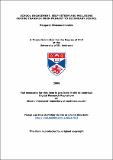Files in this item
School engagement, self-esteem and wellbeing during transfer from primary to secondary school
Item metadata
| dc.contributor.advisor | Boyle, P. J. | |
| dc.contributor.advisor | Astell, Arlene Jean | |
| dc.contributor.author | Horobin, M. Vivienne | |
| dc.coverage.spatial | 354 | en |
| dc.date.accessioned | 2009-05-28T15:51:46Z | |
| dc.date.available | 2009-05-28T15:51:46Z | |
| dc.date.issued | 2009-06-25 | |
| dc.identifier.uri | https://hdl.handle.net/10023/693 | |
| dc.description.abstract | For many years, educators, psychologists and parents have expressed concern about the apparent deterioration of pupil motivation and performance after children move to secondary school. This study used a longitudinal design to examine the transfer process from the perspective of a group of 393 children (195 boys, 198 girls) as they moved from 19 primary schools to four secondary schools in Fife. Children’s self-perceptions of school commitment, school belonging, school participation, self-esteem and global wellbeing were evaluated four times over a 13 month period, twice before transfer in the final year of primary school and twice after transfer in the first year of secondary school. Information was also collected about family and home life, emotions, lifestyle and school on each occasion. The data was analysed using multilevel modelling in order to examine how each of the five outcome variables changed over the time of the study, and how they related to a series of independent variables. It was anticipated that changes in these outcomes may have occurred immediately after the move to secondary school, perhaps followed by an improvement six months later after they had adapted to changes and settled in to their new schools. The results showed that, contrary to expectations, all outcomes except school participation recorded an improvement at wave 3, immediately after the transfer to secondary school. However, there was some evidence that after an initial ‘honeymoon period’, children perceived certain aspects of school in a less positive light and by wave 4 there was a decline in all outcomes except for the perception of self-esteem, which continued to improve. Since wave 4 was only a few months after transition, a significant change in children’s views is seen quite quickly after transfer. It is not clear whether this represents a return to a more realistic level or if this signals the beginning of a more prolonged negative attitude towards school and education in general. The general conclusion is that the process of transfer to secondary schools is well managed, but it might be helpful for induction programmes to prepare children for the changes in teaching and learning methods that might be encountered, and perhaps other types of programme might be beneficial during the first year. | en |
| dc.format.extent | 2150529 bytes | |
| dc.format.mimetype | application/pdf | |
| dc.language.iso | en | en |
| dc.publisher | University of St Andrews | |
| dc.subject | Self-esteem | en |
| dc.subject | Wellbeing | en |
| dc.subject | School transfer | en |
| dc.subject | Transition | en |
| dc.subject | School commitment | en |
| dc.subject | School belonging | en |
| dc.subject | School participation | en |
| dc.subject | Primary and secondary schools | en |
| dc.subject.lcc | LB3064.4G7H7 | |
| dc.subject.lcsh | Students, Transfer of--Scotland--Fife | en_US |
| dc.title | School engagement, self-esteem and wellbeing during transfer from primary to secondary school | en |
| dc.type | Thesis | en |
| dc.type.qualificationlevel | Doctoral | en |
| dc.type.qualificationname | PhD Doctor of Philosophy | en |
| dc.publisher.institution | The University of St Andrews | en |
This item appears in the following Collection(s)
Items in the St Andrews Research Repository are protected by copyright, with all rights reserved, unless otherwise indicated.

